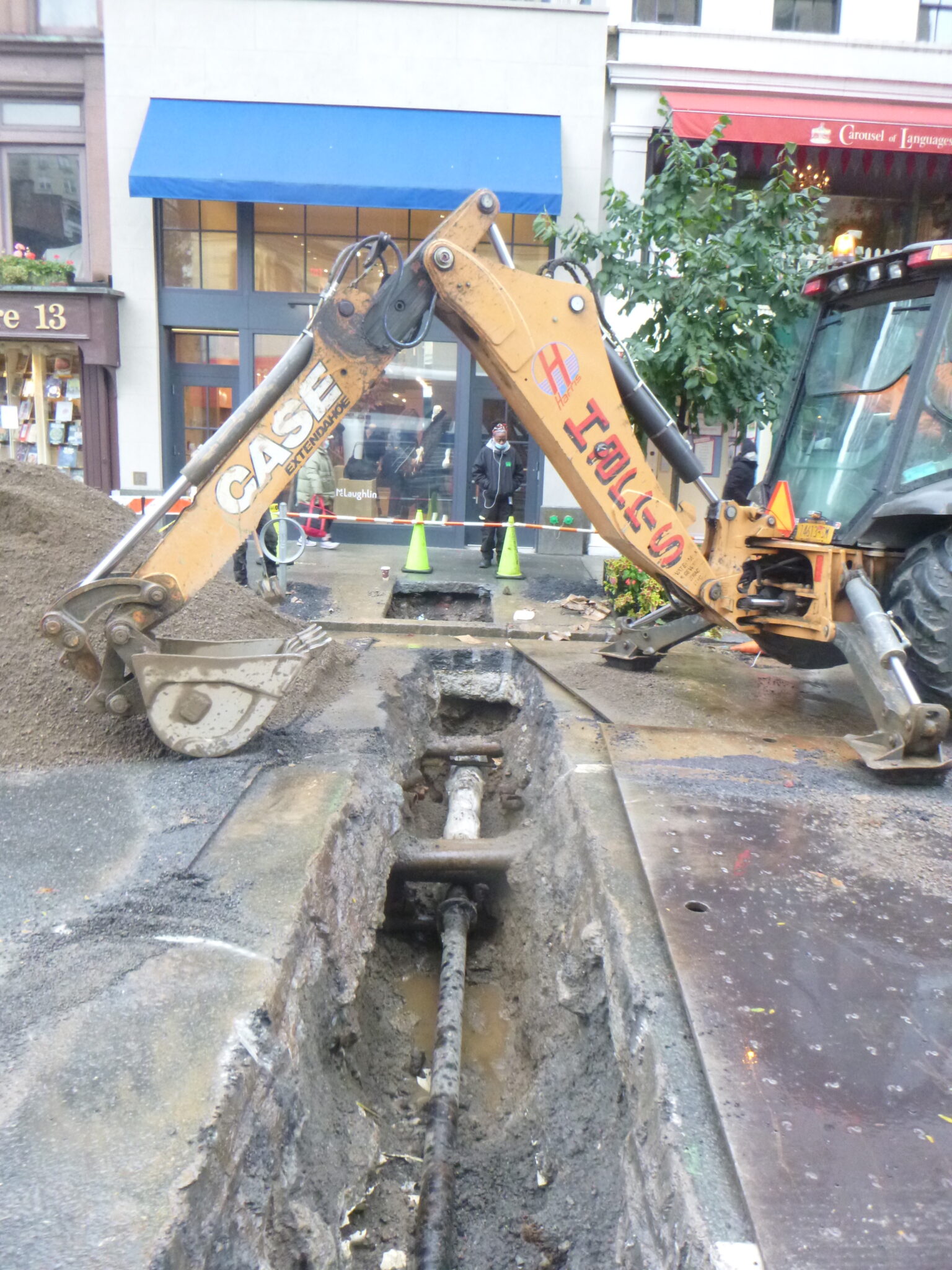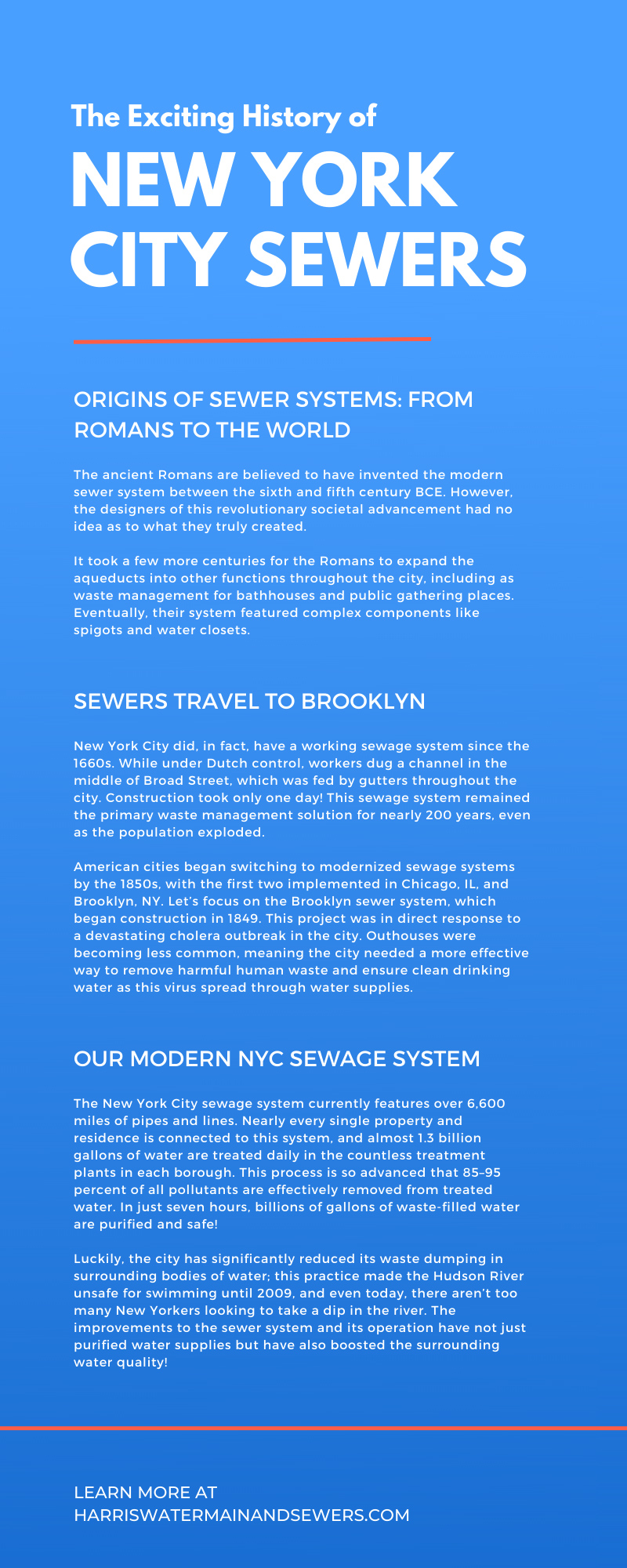Sewers have had an important role in the history of New York City—we’ll go as far as to say their role is quite exciting! At the very least, NYC sewer systems are how we as a business came to be just four generations ago. In that time, we’ve worked on thousands of the pipes and systems that lie beneath all five boroughs. And throughout those 100 years of experience, we’ve seen how technology and advancements have improved this city’s plumbing as a whole. But things certainly have been different since Abraham Harris started our company following World War I.
Let’s explore the origins of sewer systems, how they were modernized, and what makes New York City’s plumbing so unique and fascinating. Through it, you’ll have a far better understanding of how these five boroughs can supply water to nearly 10 million residents and a deeper appreciation for the hard work of early New Yorkers who truly made this city the best on earth.
Origins of Sewer Systems: From Romans to the World
The ancient Romans are believed to have invented the modern sewer system between the sixth and fifth century BCE. However, the designers of this revolutionary societal advancement had no idea as to what they truly created. The Romans did indeed build large stone waterways to transport water throughout the city, but the main function of their invention was to drain nearby marshlands and prevent flooding.
It took a few more centuries for the Romans to expand the aqueducts into other functions throughout the city, including as waste management for bathhouses and public gathering places. Eventually, their system featured complex components like spigots and water closets. Unfortunately, even those innovative ancient humans lacked a true understanding of the physics associated with their sewer system, leading to little design improvement and reccurring issues like blockages and clogs. What’s more, plumbing wasn’t connected to private residences.
Nearly 1,500 years after the fall of the Roman empire, the true potential of aqueduct design was harnessed. Many innovations of the ancient world were lost during the Dark Ages, and sanitation remained poor worldwide. However, Edwin Chadwick from London saw how the Roman design could act as a superior method of city sanitation and waste management with some tweaks and improvements. He believed that, with a comprehensive layout of hydraulic systems, clean water could be easily supplied to every resident in a given city and have a reliable way to transport waste cleanly.
The British government never allowed Chadwick to implement his grandiose plan, instead consulting with a rival engineer by the name of Joseph William Bazalgette. Bazalgette had different ideas in mind when creating his system; he wanted to drain waste into the River Thames, whereas Chadwick preferred dumping it in agricultural lands. Finally, by the 1860s, London boasted 83 miles of sewage pipes and waterways, along with a few pump stations. Inspired by Chadwick and Bazalgette, many other societies began building their own sewers globally.
Sewers Travel to Brooklyn
New York City did, in fact, have a working sewage system since the 1660s. While under Dutch control, workers dug a channel in the middle of Broad Street, which was fed by gutters throughout the city. Construction took only one day! This sewage system remained the primary waste management solution for nearly 200 years, even as the population exploded.
American cities began switching to modernized sewage systems by the 1850s, with the first two implemented in Chicago, IL, and Brooklyn, NY. Let’s focus on the Brooklyn sewer system, which began construction in 1849. This project was in direct response to a devastating cholera outbreak in the city. Outhouses were becoming less common, meaning the city needed a more effective way to remove harmful human waste and ensure clean drinking water as this virus spread through water supplies.
New York had over seventy miles of pipes and lines in just five years. And about sixty years after that, most residents in NYC had sewage services in their homes. This was true even for many tenement/affordable housing properties, thanks to the Tenement Act of 1901, which mandated every apartment have at least one water closet per unit.
Our Modern NYC Sewage System
The New York City sewage system currently features over 6,600 miles of pipes and lines. Nearly every single property and residence is connected to this system, and almost 1.3 billion gallons of water are treated daily in the countless treatment plants in each borough. This process is so advanced that 85–95 percent of all pollutants are effectively removed from treated water. In just seven hours, billions of gallons of waste-filled water are purified and safe!
Luckily, the city has significantly reduced its waste dumping in surrounding bodies of water; this practice made the Hudson River unsafe for swimming until 2009, and even today, there aren’t too many New Yorkers looking to take a dip in the river. The improvements to the sewer system and its operation have not just purified water supplies but have also boosted the surrounding water quality!
Does the trusty NYC sewer system sometimes fail? Absolutely. Many locals might remember the infamous blackout of 1977. During this power outage, sewer pumps ceased functioning, and the city spilled over 145 million gallons of contaminated water into rivers surrounding Manhattan and Brooklyn. And there are even myths surrounding the sewage system, such as the belief that some alligators occupy the lines below our city. The first sighting of gators in the sewers was reported by the New York Times in 1935, and rumors continue to circulate to this day.
The history of New York City sewers is undeniably exciting—without thousands of years of innovation and design, our city would be a disease-ridden, uninhabitable ghost town. Plus, there are many myths and interesting stories associated with the pipes beneath our feet that add to the intrigue of NYC. Luckily, we live in a time when sewers have never been more effective, and our team at Harris Water Main and Sewer is committed to ensuring your residence is effectively attended to in the event of plumbing issues. Our sewer line replacement NY services and other capabilities are here to satisfy the DEP and your needs.






















